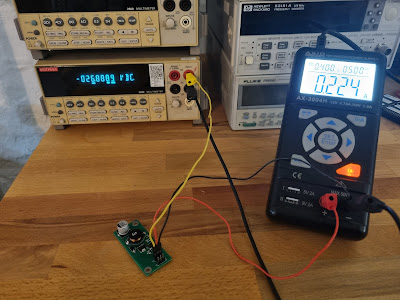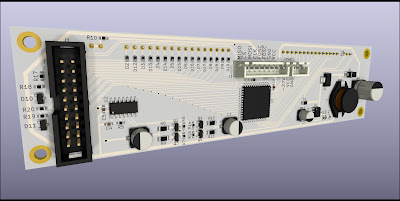For the -27V supply I mentioned in the first part of the series (
https://pakahuszar.blogspot.com/2023/02/vfd-mania-1-preface.html), I wanted to have something cheap, and from easily available parts.
Yes I know, that the MC34063 is old, not to effective, but still widely available, has calculator, tons of circuit configuration in the datasheet, and extremely cheap.
As I wanted to create -27V from the 5V supply (I want to run the module on the way, to have only a single supply input), I decided to have an additional external transistor, as even with 100mA output, the switching current on the internal transistor would be over 1.5A, what is the maximum of it.
The required circuit configuration is on the datasheet (choose the NPN external switch version), so I just used it in my design.
Ordered the panel, arrived, and built it.
PIC
On first switch on, no output, just some smoke. 😕
It happened, let say 6 month ago. I put the whole project aside as I had many more things to do.
A few days ago it started "itching", to do something with it.
Actually, I looked for other possible solutions than the MC34063 (found some, but the component availability is still an issue)
Then I revisited the datasheet, and the original schematic, to figure out, what is the problem.
Redrawn it a bit different form, and realized something.
The R4 in the schematic above (according to my understanding) has the role, to switch of the transistor, compensate the base capacitance (it is low, but still exists). Then I realized, it will not fulfill its role. When the inductor voltage fall below -0.6-0.7V, it switch the transistor back on. The R4 should be between the base and emitter instead of the base and the ground if even needed.
I just removed it, and the circuit started to work perfectly.
It draw ~200mA from the 5V supply without load. Not good, but acceptable:
Checked, in the datasheet, if I was the idiot, when designed it.
It looks like not. The design flaw is coming from the datasheet.
Finally, I wanted to see the supply noise. I seen some weird waveforms, at ~22.5kHz, what is not the expected switching frequency. (First real use of my shiny new Rigol MSO5074 oscilloscope)
Then it pop into my mind, what is the input the supply gets.
Oh, my! The yellow is the output of the newly built converter, the blue is the output of the used Axiomet bench PSU. Ok, I realized, why to use linear bench PSU (or maybe a good trusted switching one) when it come to noise measurement.
I'm planning to do that measurement later on.
Next part is planned on the filament supply.
To be continue...












